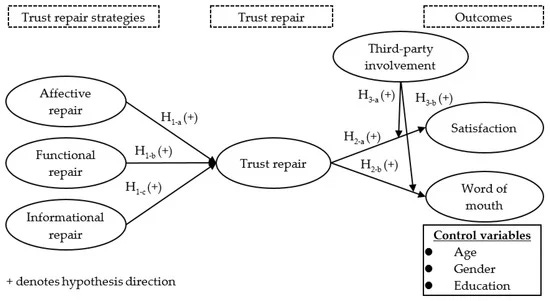Post f up trust repair
Current evidence seems to suggest that trust repair, although never guaranteed, is easier and more obvious to 'achieve' than you might think. Here's the gist
Everyone effs up. Much can be done to limit both the likelihood and severity of such events or circumstances, but what can we do when it actually happens?
In a 2009 paper, Xie et al. proposed the 'Conceptual model of trust repair after negative publicity'.
The paper itself is hard to get access to for everyday folks. Here’s the abstract:
“The purpose of the comprehensive model presented here is to explain the underlying mechanism by which corporations can repair customer trust after negative publicity. The study sets out to examine corporate informational, affective, and functional initiatives managers take to influence three trustworthiness factors—competence, benevolence, and integrity—and to elicit forgiveness. A scenario-based experiment conducted to test the conceptual model found support for most hypotheses. According to the results, rebuilding a trustworthy image and earning consumer forgiveness are crucial steps in repairing consumer trust. A clear pattern of influential factors for different trustworthiness aspects was found, indicating that affective initiatives are the most effective strategy in shaping a corporate image of integrity and benevolence, and that providing sufficient information is a key activity for enhancing consumers' judgment about the firm's competence.”
Let me break down how I interpreted this and related work when I conducted a recent review of the literature for a government client (please note that this specific study explored trust repair after ‘negative publicity’. We should be cautious to transfer the results to other contexts without consideration of the broader literature, how that maps to our own experience etc.).
Competence, benevolence and integrity are perhaps the three most common ‘qualities’ of trustworthiness that feature in the literature
If we assume that trust is a mental process that leads to a mental state (see more on the definitional nuance of trust here), and that this process is largely active, directly impacted by information etc., then these three qualities directly contribute to the trust one party feels / directs towards another party
When an event or series of events occurs that ‘breaks’ trust (in this case ‘negative publicity’) - in effect, something that contradicts the belief people have about the competence, benevolence or integrity of the organisation - the organisation is faced with a series of choices about how to act in response to the event and its various implications
The experimental intervention explores informational, affective and functional tactics, each of which has the capacity to change the narrative, demonstrate ownership of negative consequences, show support for impacted parties and reinforce the original belief in the three qualities (competence, benevolence and integrity)
Affective initiatives - those relating to moods, feelings and attitudes - seem to most contribute to re-establishing the belief in an organisation’s benevolence and integrity (this makes a lot of sense as trust very likely has a lot of automatic and emotional contributions. Sorry to those who still believe in the fiction of the homo economicus!)
Informational initiatives - using our framing, we may like to think of this as ‘evidence of trustworthiness’ - seem to most contribute to re-establishing the belief in an organisation’s competence
These tactics seem to support the process of forgiveness
The process of forgiveness helps to re-establish the belief in the organisation’s trustworthiness
Problematically, this study focuses a little too much on trust and not on whether the organisation is in fact trustworthy (this distinction matters). This type of work is also incredible hard to replicate in real world settings, so we should be informed or inspired by, not dogmatically convinced by the results.
Those and other issues aside, I believe there might be a better way to look at the process of ‘trust building’ and ‘trust repair’.
I have previously proposed that the best way to earn trust is:
Be worthy of it (in other words, do the work), and
Give good evidence of the fact you are indeed trustworthy (make it easy for folks to see and fully experience this great work you’ve done)
In practice this is about the proactive process of designing and bringing to life the 7 qualities of trustworthiness; intent, integrity, respect, fairness, openness, inclusion and competence.
You may start this process, but it’s never truly done.
By committing to such an approach, you create a context in which you are highly likely to benefit from positive trust states. When eff ups occur, for whatever reason, the process just continues. You demonstrate an openness and vulnerability through your apology. You showcase the inclusivity with which you are furthering your understanding of the impacts. You invite participation so that the process of recovery is thoughtful. You treat everyone involved with dignity and show respect during every interaction. You showcase the relationship between what you say and what you do, which helps bring to life your integrity. You show the results of your repair efforts, which reinforces competence. You consider not just those in the middle, but the folks on the edges. You make the process of repair as fair as you can.
None of this prescribes what you ought to do in a specific situation (this isn’t a roadmap or plan). Rather, these are categories of considered action that may help you design an organisation that is worthy of trust in both the good and slightly less good times.
Here’s to forgiveness.




